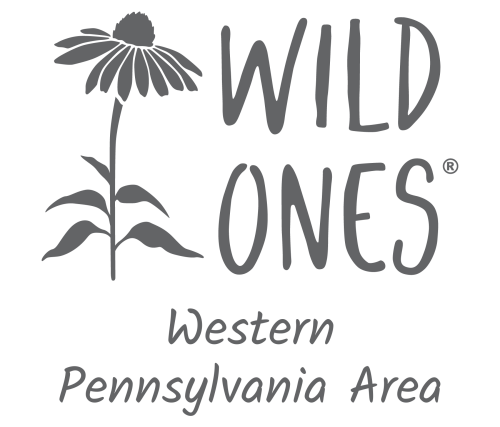Viburnums are a host plant for four species of butterflies including the Holly Blue (Celastrina argiolus), Spring Azure (Celastrina ladon), Henry’s elfin (Incisalia henrici) and the Baltimore checkerspot (Euphydryas phaeton). In the fall, a lot of these viburnums have attractive foliage and the drupes (fruit) provide food for birds. These shrubs, which provide taller structure, can be a vital part of your butterfly garden in Allegheny County. The genus name, Viburnum, derives from the Latin word for “obscure.” All of the species discussed in this post are perennials and are shrubs, though some can be small trees.
General Information about Native Plant and Pollinator Gardens
When planting a native plant and pollinator garden in Allegheny County, PA, you need to ensure that you have a selection of plants that attract other butterflies at different time of the year. Besides viburnums, other host plants that attract other butterflies and pollinators should be considered. These could include pawpaw (Asimina triloba) for zebra swallowtail, wild cherry (Prunus serotina) for eastern tiger swallowtails, and trumpet creeper (Campsis radicans) for hummingbirds.
In addition to the plants, you need to provide a source of water such as a birdbath or water feature, shelter for animals, and nesting locations for birds. Be sure to include plants of different heights for perching. Resources you can use for more information on butterfly gardening in Allegheny County include the Penn State Master Gardeners of Allegheny County, Wild Ones Western Pennsylvania Chapter, Audubon Society of Western Pennsylvania, Xerces Society, and Phipps Conservatory and Botanical Garden.
Location of Allegheny County, Pennsylvania
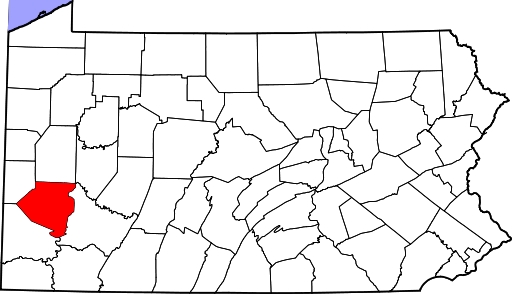
Allegheny County is located in southwestern Pennsylvania. Pittsburgh is the largest city in the county.
USDA Plant Hardiness Zones in Allegheny County, Pennsylvania
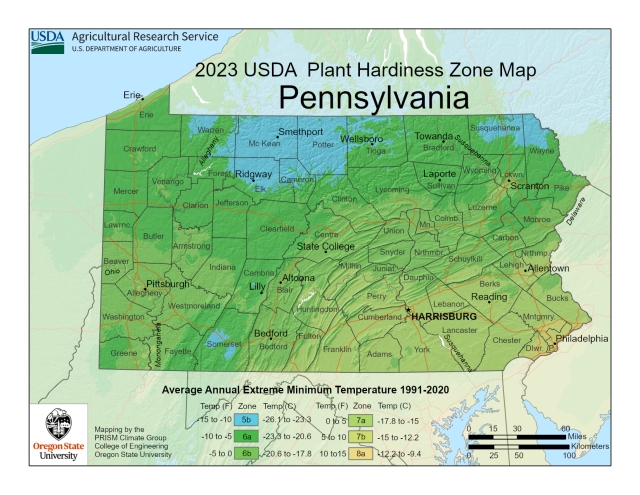
Allegheny County is located mostly within plant hardiness zone 6b. Adjacent to the Monongahela and Ohio Rivers is zone 7a. When selecting plants in Allegheny County, you will want to get those that can handle temperatures as cold as -50F.
Butterflies in Allegheny County, Pennsylvania that are hosted by Viburnums (Viburnum spp.)
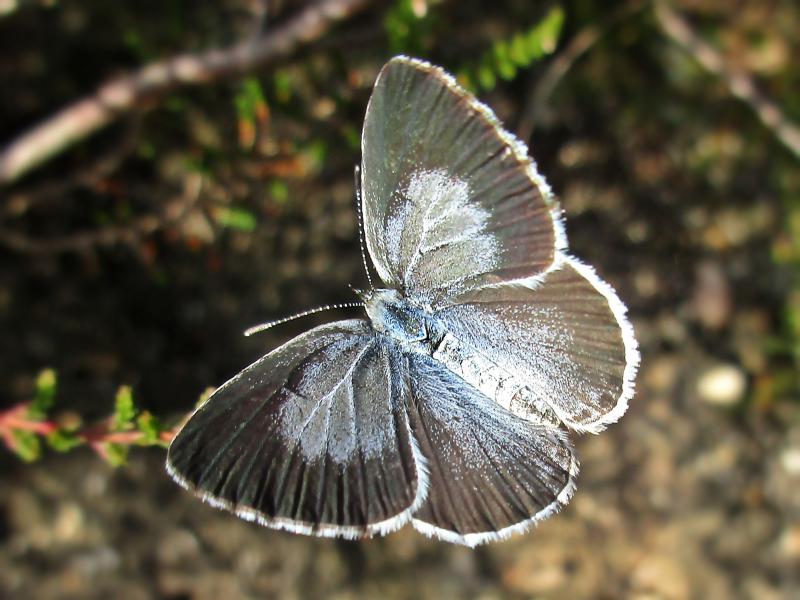
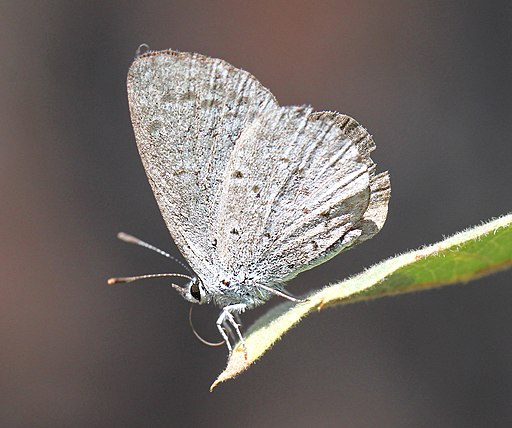
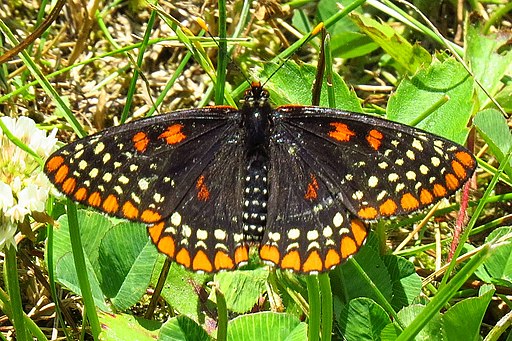
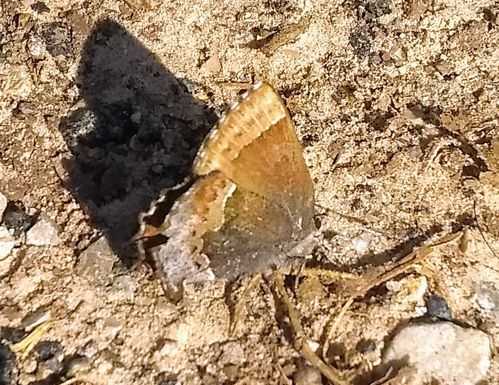
Henry’s Elfin (Callophrys henrici)
The Henry’s elfin has a dark brown upperside and an underside that is two toned brown. As an adult it is a small butterfly with a wingspan of 0.8 in (2.0 cm) to 1.0 (2.5 cm).
The light green eggs are laid on leaves or flower buds of the host plant. The larva when hatched range from greenish-yellow to red-brown in color. The pupas are orange brown in color and this species has one brood a year.
Holly Blue (Celastrina argiolus)
The holly blue has a silvery blue color with ivory dots on the upperside and a silvery-white underside. Adults have a wingspan of 1.4 in (3.6 cm) to 3.5 in (8.9 cm).
The whitish eggs are laid on the leaves of the host plant and they have green or brown larvae. This species can have up to three broods throughout the growing season.
Spring Azure (Celastrina ladon)
The Spring Azure is a silvery metallic blue on the upperside and has a silvery underside. The females, unlike the males, have a black margin on the wings. A fully grown adult has a wingspan of 0.87 in (2.2 cm) to 1.38 in (3.5 cm).
The whitish eggs are laid on the flower buds of host plants. Larvae are green colored with accents of brown. The chrysalis overwinters and there can be several broods a year with more in the south and less in the north.
Baltimore Checkerspot (Euphydryas phaeton)
The Baltimore Checkerspot is a speckled white, orange and black butterfly. This butterfly is found in the eastern United States and southern Canada from the mid-west and east. Adults have a wingspan of 1.6 in (4.1 cm) to 2.5 in (6.4 cm).
The eggs of this species are yellow and become a reddish-tan color with age (wildadirondacks.org). The caterpillars are black with orange stripes (Pyle 1981). There is one brood that flies from May to July. This butterfly is so named because the color resembles the crest of Lord Baltimore (Pyle 1981).
List of Viburnums that are Native or Nearly Native in Allegheny County, Pennsylvania
1. Maple-leaf Viburnum (Viburnum acerifolium), a Viburnum for Dry to Moist Well-drained Soils
When planted in a butterfly garden, this species does best in places that are shaded, but can handle some sun if dappled. During establishment it needs to be watered frequently. Pruning can be done after flowering to promote bushier growth.
Suitable herbaceous companion plants include New England Aster (Symphyotrichum novae-angliae), black-eyed susan (Rudbeckia hirta), wild indigo (Baptisia australis). Oakleaf hydrangea (Hydrangea quercifolia) and eastern redbud (Cercis canadensis) are suitable woody plants that match the height. All of the these species listed compliment the foliage of this plant in the autumn.
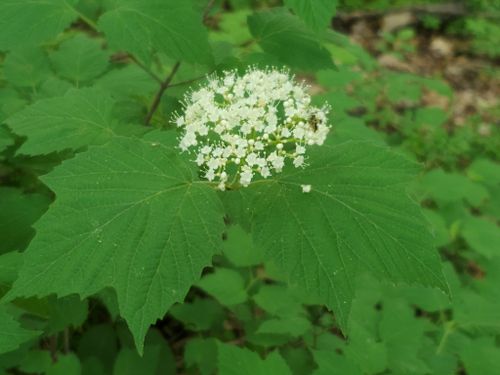
Facts about Maple-leaf Viburnum
- Native to Pennsylvania: Yes (Kartesz 2015)
- Native to Allegheny County: Yes
- Natural Habitat: Rich forests, woodlands and woodland thickets that are rocky and have medium to dry soils.
- Height: 3 ft (0.9 m) to 6 ft (1.8 m)
- Flower Color: cream to white
- Flowering Period: June
- USDA Hardiness Zone: 3-8
Gardening with Maple-leaf Viburnum
In your Allegheny County, PA butterfly garden this plant requires part-shade or dappled sunlight and dry to moist soils that are well-drained. This plant can handle full sun conditions in a garden, but it does best in shaded conditions (Wyman 1959).
2. Southern Arrow-wood (Viburnum dentatum), a Viburnum for Moist to Medium Well-drained Soils
Southern arrow-wood can handle both full sun to partial-shade, however, full sun is needed for the best fruit production. Planting should occur in the early spring or autumn to ensure that the plants have time to establish roots before the growing season. Plants should have a consistent amount of water during establishment. Though, once established they can handle drier soils, if needed.
Suitable herbaceous companion plants include butterfly weed (Asclepias tuberosa), little bluestem (Schizachyrium scoparium), wild geranium (Geranium maculatum). Some companion shrubs are New Jersey tea (Ceanothus americanus) and spicebush (Lindera benzion). Some of these plants are also hosts to other butterflies.
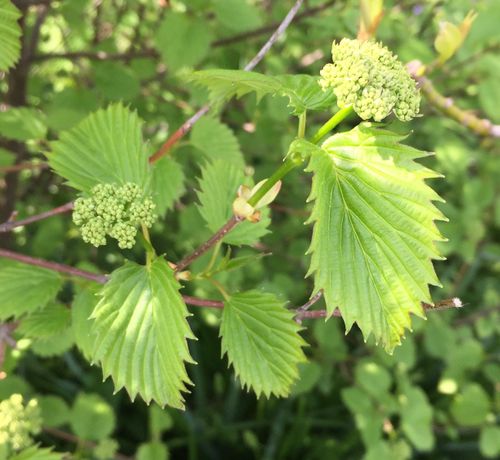
Facts about Southern Arrow-wood
Viburnum dentatum var. dentatum in Pennsylvania
- Native to Pennsylvania: Yes, mainly southeastern PA and Greene County in southwest (Kartesz 2015)
- Native to Allegheny County: No
- Natural Habitat: Rich forests, woodlands, floodplains, and wetlands
- Height: 5 ft (1.5 m) to 15 ft (4.6 m)
- Flower Color: cream to white
- Flowering Period: March to June
- USDA Hardiness Zone: 2-8
Gardening with Southern Arrow-wood
In your Allegheny County, PA butterfly garden, this plant requires full sun to part shade and moist well-drained soils. In a garden situation it can handle drier soils (Flemer 1984). This viburnum has brilliant color in the fall, which gives added value to your garden.
3. Hobblebush (Viburnum lantanoides), a Viburnum for Moist to Wet Soils
Hobblebush can currently handle the hardiness zone of Allegheny County (except next the Monongahela River and Ohio rivers). However, in the future it experience heat-stress from climate change induced warming. It enjoys places that have partial shade and are moist to wet. Given that it is at the edge of its hardiness zone, it might be better in more shade. Planting should occur in the early spring or autumn to ensure sufficient root growth.
Some suitable herbaceous companion plants include columbine (Aquilegia canadensis), foam-flower (Tiarella cordifolia), Heuchera (Heuchera spp.), and Christmas fern (Polystichum acrostichoides). Red-osier dogwood (Cornus alba) is an excellent woody companion.
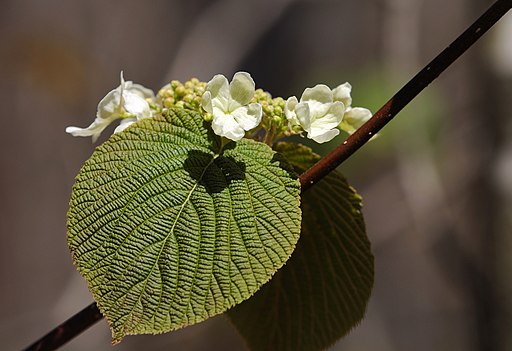
Facts about Hobblebush
- Native to Pennsylvania: Yes, generally throughout, except for southeast and southwest (Kartesz 2015)
- Native to Allegheny County: No
- Natural Habitat: Rich woods that are moist, stream banks, and swamps
- Height: 3 ft (0.9 m) to 10 ft (3.0 m)
- Flower Color: white to pink
- Flowering Period: May to June
- USDA Hardiness Zone: 3-6
Gardening with Hobblebush
In your Allegheny County, PA butterfly garden, this plant requires part shade and moist to wet well-drained soils.
4. Nanny-Berry (Viburnum lentago), a Viburnum for Medium to Moist Well-drained Soils
Nanny-Berry likes places that have full sun to partial shade and well-drained soils. Similar to the other viburnums, planting needs to occur in the early spring or autumn to ensure adequate root development. This species generally likes consistent moisture during root development.
Some suitable herbaceous companion plants, given the height of this plant include Joe-Pye Weed (Eutrochium purpureum), obedient plant (Physotegia virginiana), Virginia creeper (Parthenocissus quinquefolia), woodland phlox (Phlox divaricata), and Ironweed (Vernonia noveboracensis), if in a sunny area. Virginia creeper (Parthenocissus quinquefolia), if given a place to climb, compliments the autumn foliage of this plant.
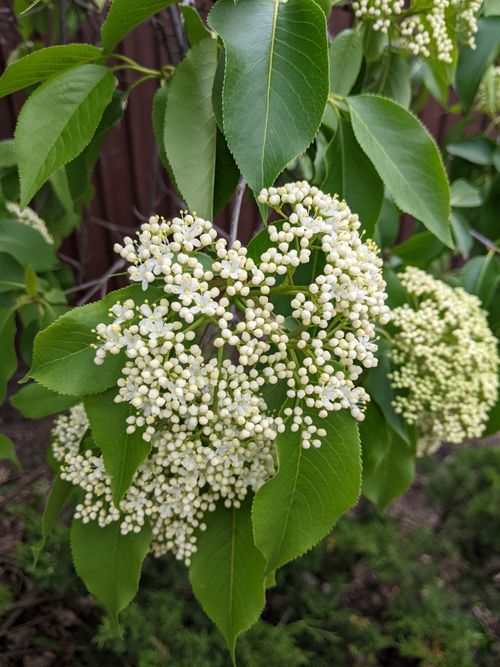
Facts about Nanny-Berry
- Native to Pennsylvania: Yes, generally throughout, except for south-central (Kartesz 2015)
- Native to Allegheny County: Yes
- Natural Habitat: Rich woods that are moist, stream banks (King 1912), swamps, roadsides (Arnold Arboretum 1919), wood edges (Mohlenbrock (1954), and thickets (McCormac and Schneider 1994)
- Height: 15 ft (4.5 m) to 18 ft (5.5 m)
- Flower Color: white to cream
- Flowering Period: May to June
- USDA Hardiness Zone: 2-8
Gardening with Nanny-Berry
In your Allegheny County, PA butterfly garden, this plant requires full sun to part shade and soils that are medium to moist and well-drained.
5. Possumhaw (Viburnum nudum), a Viburnum for Medium to Wet Well-drained Soils
Possumhaw is a small to medium sized shrub that can handle medium moisture soils, but especially prefers places that are moist and well-drained. Planting should occur in the early spring or autumn to allow for root development and the soils need to have some compost or manure for nutrients.
Suitable herbaceous companions, given the preferred habitat include swamp milkweed (Asclepias incarnata), blueflag iris (Iris versicolor), and tussock sedge (Carex stricta), in very wet places. Some companion shrubs include sweet pepperbush (Clethra alnifolia), and northern bayberry (Morella pennsylvanica).
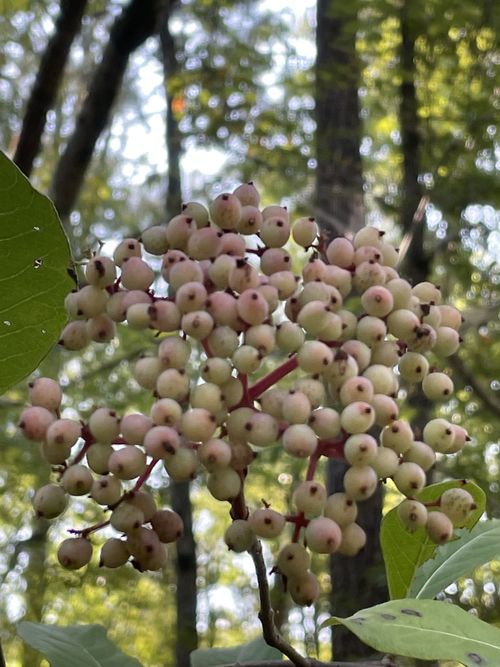
Facts about Possumhaw
Viburnum nudum var. cassinoides and var. nudum in Pennsylvania
- Native to Pennsylvania: Yes, throughout, except southwest (var. cassinoides), rare in southeast (var. nudum) (Kartesz 2015)
- Native to Allegheny County: No
- Natural Habitat: Swamps (wikipedia), seepage swamps (Belden and Derge 2003 and Sundell, et al 1999), and bogs (MacRoberts, et al 2004)
- Height: 5 ft (1.5 m) to 15 ft (4.6 m)
- Flower Color: white to cream
- Flowering Period: April to June
- USDA Hardiness Zone: 5-9
Gardening with Possumhaw
In your Allegheny County, PA butterfly garden, this plant requires full sun to partial shade and medium to wet well-drained soils.
6. Highbush-Cranberry (Viburnum opulus), a Viburnum for Medium to Moist Well-drained Soils
Highbush-cranberry is another small to medium sized shrub that likes medium to moist soils, but tends to favor the moist end of the spectrum. When planting this shrub make sure that you get the native variety (americanum) and not the European variety (opulus), which is exotic to North America. Variety americanum has stalked petiolar glands, while variety opulus has sessile petiolar glands. In time this species may experience heat stress, due to being at the upper end of its hardiness zone.
Suitable herbaceous companion plants for moist conditions include marsh marigold (Caltha palustris), cardinal flower (Lobelia cardinalis), and great blue lobelia (Lobelia siphilitica). Companion shrubs include gray dogwood (Cornus racemosa) and buttonbush (Cephalanthus occidentalis).
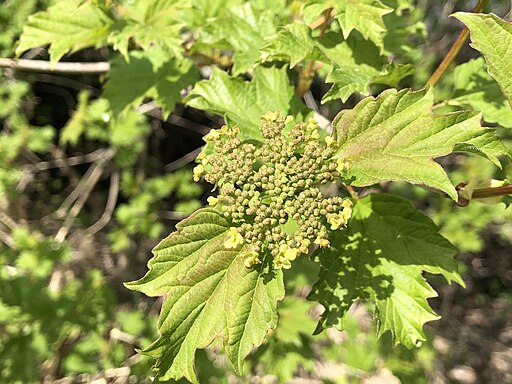
Facts about Highbush-Cranberry
Viburnum opulus var. americanum: Native and rare in Pennsylvania
Viburnum opulus var. opulus: Exotic to North America
- Native to Pennsylvania: Yes, rare and scattered throughout (var. americanum) (Kartesz 2015)
- Native to Allegheny County: No
- Natural Habitat: lowland woods (Macdonald 2003), moist woods (Bird 1961), rivershores and banks (Hosie 1938), shrub swamps (Thomson 1944), gravelly calcareous places (Wiegand and Eames 1926), swamps and rarely dry woods (McVaugh 1958), and roadsides and field edges (Go Botany)
- Height: 8 ft (2.4 m) to 16 ft (4.9 m)
- Flower Color: yellow to white
- Flowering Period: April to June
- USDA Hardiness Zone: 2-7
Gardening with Highbush-Cranberry
In your Allegheny County, PA butterfly garden, this plant requires full sun to part shade and medium to moist well-drained soils. This species has two varieties, one of which, var. opulus, is exotic to North America. Variety americanum is native to North America.
7. Smooth Blackhaw (Viburnum prunifolium), a Viburnum for All Soils
Smooth blackhaw is a short to tall shrub that can handle most conditions in the garden including poor soils. However, the exposure should be in full sun to partial-shade. Also like other viburnums, it should be planted at a time when it will have time to develop roots before the warm season.
Due to its height, smooth blackhaw should generally be planted with other tall shrubs such as winterberry holly (Ilex verticillata) and sweet pepperbush (Clethra alnifolia). Suitable small trees include eastern redbud (Cercis canadensis) and witch-hazel (Hamamelis virginiana). Purple Joe-Pye weed (Eutrochium purpureum), would basically be the only herbaceous plant companion considering the height of the adjoining shrub.
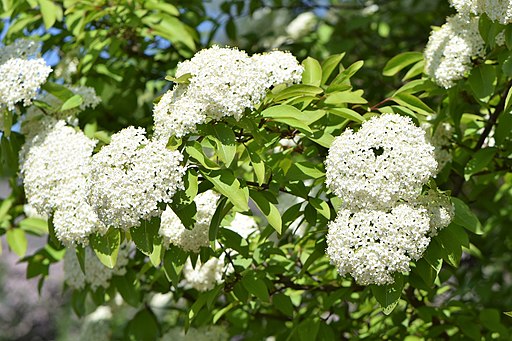
Facts about Smooth Blackhaw
- Native to Pennsylvania: Yes, generally throughout, except for northern counties (Kartesz 2015)
- Native to Allegheny County: Yes
- Natural Habitat: Open areas, upland woods, floodplains (Gaddy 2008), disturbed habitats (Clark and Bauer 2001), thickets (Fernald 1936)
- Height: 7 ft (2.1 m) to 30 ft (9.1 m)
- Flower Color: white
- Flowering Period: May to June
- USDA Hardiness Zone: 3-9
Gardening with Smooth Blackhaw
In your Allegheny County, PA butterfly garden, this plant requires full sun to part-shade and dry to moist well-drained soils. This plant can also handle poor soils, making it versatile for most gardens.
8. Downy Arrow-wood (Viburnum rafinesquianum), a Viburnum for Medium Well-drained Soils
Downy arrow-wood is a small shrub that especially relishes full sun to partial-shade in medium moisture soils. When planted, an ample amount of mulch should be used. Given the height, spotted Joe-Pye weed (Eutrochium maculatum) and purple coneflower (Echinacea purpurea) are suitable herbaceous companions. Companion shrubs include pinxter flower (Rhododendron periclymenoides) and sweetspire (Itea virginica).
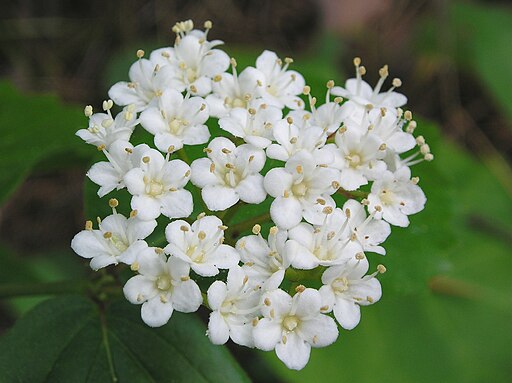
Facts about Downy Arrow-wood
- Native to Pennsylvania: Yes, throughout, but scattered (Kartesz 2015)
- Native to Allegheny County: Yes
- Natural Habitat: open woodlands, rocky hillsides (Reaume 2009), rocky shorelines (Rousseau 1974), limestone savanna (Alvar) (Catling and Brownell 1995), and dry thickets (Maycock and Eahselt 1997), and low woodlands (Fernald 1942)
- Height: 6 ft (1.8 m) to 10 ft (3 m)
- Flower Color: white to cream
- Flowering Period: May to June
- USDA Hardiness Zone: 3-8
Gardening with Downy Arrow-wood
In your Allegheny County, PA butterfly garden, this plant requires full sun to part shade and dry well-drained soils. This species is noted for its bronze-purple foliage in the fall (Koller 1981).
9. Rusty Blackhaw (Viburnum rufidulum), a Viburnum for Medium to Wet Soils
Rusty blackhaw looks very similar to the smooth blackhaw (Viburnum prunifolium). However, the leaves of the rusty blackhaw have a reddish hue to them from rusty colored pubescence. Planting needs to be done in the early spring or in the autumn to allow for adequate root growth.
Suitable garden companions include eastern redbud (Cercis canadensis), black chokeberry (Aronia melanocarpa), and American beautyberry (Callicarpa americana).
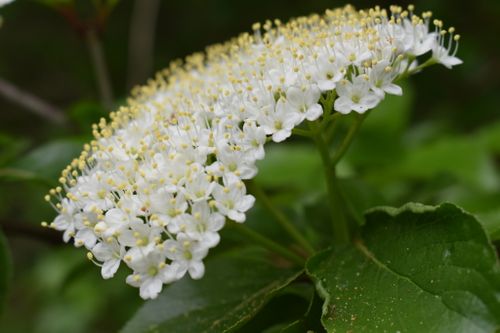
Facts about Rusty Blackhaw
- Native to Pennsylvania: No (Kartesz 2015)
- Native to Allegheny County: No
- Natural Habitat: rocky and dry woods, woodlands (Wofford, et al 1979), glades (Steyermark 1940), limestone (Thompson, et al 2005), cedar barrens (Carr 1944), calcareous prairies (MacRoberts and MacRoberts 1996), xeric sandhills (MacRoberts and MacRoberts 1995), and disturbed habitats (Clark and Bauer 2001)
- Height: 6 ft (1,8 m) to 20 ft (6.1 m) or up to 40 ft (12.2 m) (Arnold Arboretum 1923)
- Flower Color: white to cream
- Flowering Period: April to May
- USDA Hardiness Zone: 5-9
Gardening with Rusty Blackhaw
In your Allegheny County, PA butterfly garden, this plant requires full sun to part-shade and soils that are medium to dry well-drained. This shrub has deep red foliage in the fall (Goodrich 1973).
References
- Arnold Arboretum. 1923. Arborescent Viburnums. Bulletin of Popular Information. 9 (8): 30-31.
- Arnold Arboretum. 1919. Viburnum lentago. Bulletin of Popular Information. 5 (7): 28.
- Belden, Allen and Katherine L. Derge. 2003. The flora and fauna of Virginia Army National Guard OMS No. 1 and No. 2 near Sandston, Henrico County, Virginia. Banisteria 22: 22-42.
- Bird, Ralph Durham. 1961. Ecology of the aspen parkland of western Canada in relation to land use. (Ottawa: Canada Department of Agriculture).
- Bouchard, Andre’, Denis Barabe’, Madeliene Dumais, and Stuart Hay. 1983. The Rare Vascular Plants of Quebec. (Ottawa, ON: National Museum of Natural Sciences).
- Carr, Lloyd G. 1944. A New Species of Houstonia from the Cedar Barrens of Lee County, Virginia. Rhodora 46: 306-310.
- Catling, Paul M. and Vivian R. Brownell. 1995. A review of the Great Lakes Region: Distribution, floristic comparison, biogeography, and protection. The Canadian Field-Naturalist 109 (2): 143-171.
- Clark, Ross C. and Ryan M. Bauer. 2001. Woody Plants of Six Northern Kentucky Counties. Journal of the Kentucky Academy of Science 62: 39-51.
- Fernald, Merritt Lyndon. 1942. The Seventh Century of additions to the flora of Virginia. Rhodora 44: 457-479.
- Fernald, Merritt Lyndon. 1936. Plants from the Outer Coastal Plain of Virginia (continued). Rhodora 38: 414-452.
- Flemer, William III. 1984. Island and Median-Strip Planting. Arnoldia 44 (4):
- Gaddy, L.L. 2008. A New Sessile-Flowred Trillium (Liliaceae: Subgenus Phyllantherum) from South Carolina. Phytologia 90 (3): 382-390.
- Goodrich, Ross. 1973. Fall color in Southern California. Lasca Leaves 23: 107-109.
- Hosie, R.C. 1938. Botanical Investigations in Batchawana Bay Region, Lake Superior. National Museum of Canada: Bulletin No. 88.
- King, Wilbur. 1912. The Flora of Northamption County, Pennsylvania. Torreya 12: 208-215.
- Koller, Gary. 1981. Shrubs for Hillsides and Embankments. Arnoldia 41: 193.
- Macdonald, Ian D. 2003. A rare plant survey of the Wainwright Dunes Ecological Reserve. (Edmonton, Alberta: Alberta Sustainable Resource Development).
- Maycock, Paul F. and Dianne Eahselt. 1997. An inventory of ecologically siginificant natural vegetation in the province of Ontario: 1. Essex County. The Canadian Field-Naturalist 101: 474-486.
- McCormac, J.S. and G.J. Schneider. 1994. Floristic Diversity of a Disturbed Western Ohio Fen. Rhodora 96: 327-353.
- McVaugh, Rogers. 1958. Flora of the Columbia County area, New York. (Albany, NY: University of the State of New York).
- MacRoberts, Michael H., Barbara R. MacRoberts, and Lynn Stacey Jackson. 2004. Observations of Parnassia grandifolia DC. (Saxifragaceae) in the West Gulf Coast Plain. Phytologia 86: 98-103.
- MacRoberts, Barbara R. and Michael H. MacRoberts. 1996. The floristics of calcareous prairies on the Kisatchie National Forest, Louisiana. Phytologia 81: 35-43.
- MacRoberts, Barbara R. and Michael H. MacRoberts. 1995. Floristics of xeric sandhills in Northwestern Louisiana. Phytologia 79: 123-131.
- Mohlenbrock, R.H. 1954. Some notes on the flora of Southern Illinois. Rhodora 56: 227-228.
- Reaume, Tom. 2009. Biology of Downy Arrow-wood (Viburnum rafinesquianum). Blue Jay 67 (2): 89-96.
- Rousseau, C. 1974. Ge’ographie floristique de Que’bec/Labrador. Distribution des principales especes vasculaires. Les Presses de of I’Universite Laval. Quebec 799 pp. in (Bouchard, et al 1983).
- Steyermark, Julian. 1940. Studies on the vegetation of Missouri – I. Natural Plant Associations and Succession in the Ozarks of Missouri. Botanical Series of the Field Museum of Natural History 9 (5). Publication 485.
- Sundell, Eric, Thomas R. Dale, Carl Amason, Robert L. Stuckey, and John Logan. 1999. Noteworthy Vascular Plants From Arkansas. Sida 18: 877-887.
- Thompson, Ralph L., J. Richard Abbott, Andrew E. Shupe. 2005. Vascular Flora from Five Plant Habitats of an Abandoned Limestone Quarry in Clark County, Kentucky. Journal of the Kentucky Academy of Science 66 (1): 24-34.
- Thomson, John W. 1944. A Survey of the Larger Aquatic Plants and Bank Flora of the Brule River. Transactions of the Wisconsin Academy of Sciences, Arts, and Letters 36: 57-76.
- Wiegand, K.M. and Arthur J. Eames. 1926. The flora of Cayuga Lake Basin, New York. Vascular Plants. (Ithaca, NY: The University Memoir 92).
- Wofford, Eugene B. and Thomas S. Patrick, Loy R. Phillippe, and David H. Webb. 1979. The Vascular Flora of Savage Gulf, Tennessee. Sida 8: 135-151.
- Wyman, Donald. 1959. Viburnums. Arnoldia, Bulletin of Popular Information of the Arnold Arboretum, Harvard University. 19: 47-58.
Author’s Bio: Robert Coxe is the owner of McMullen House Bed & Breakfast LLC and Silphium Design LLC (a web development firm). Robert has a graduate degree in systematic botany and ecology and is the former State Ecologist of Delaware and a former ecologist at the Western Pennsylvania Conservancy. He is also a past-president of the Pennsylvania Academy of Science. Robert has a blog about native plant and butterfly gardens at the McMullen House Bed & Breakfast Garden Shop.
